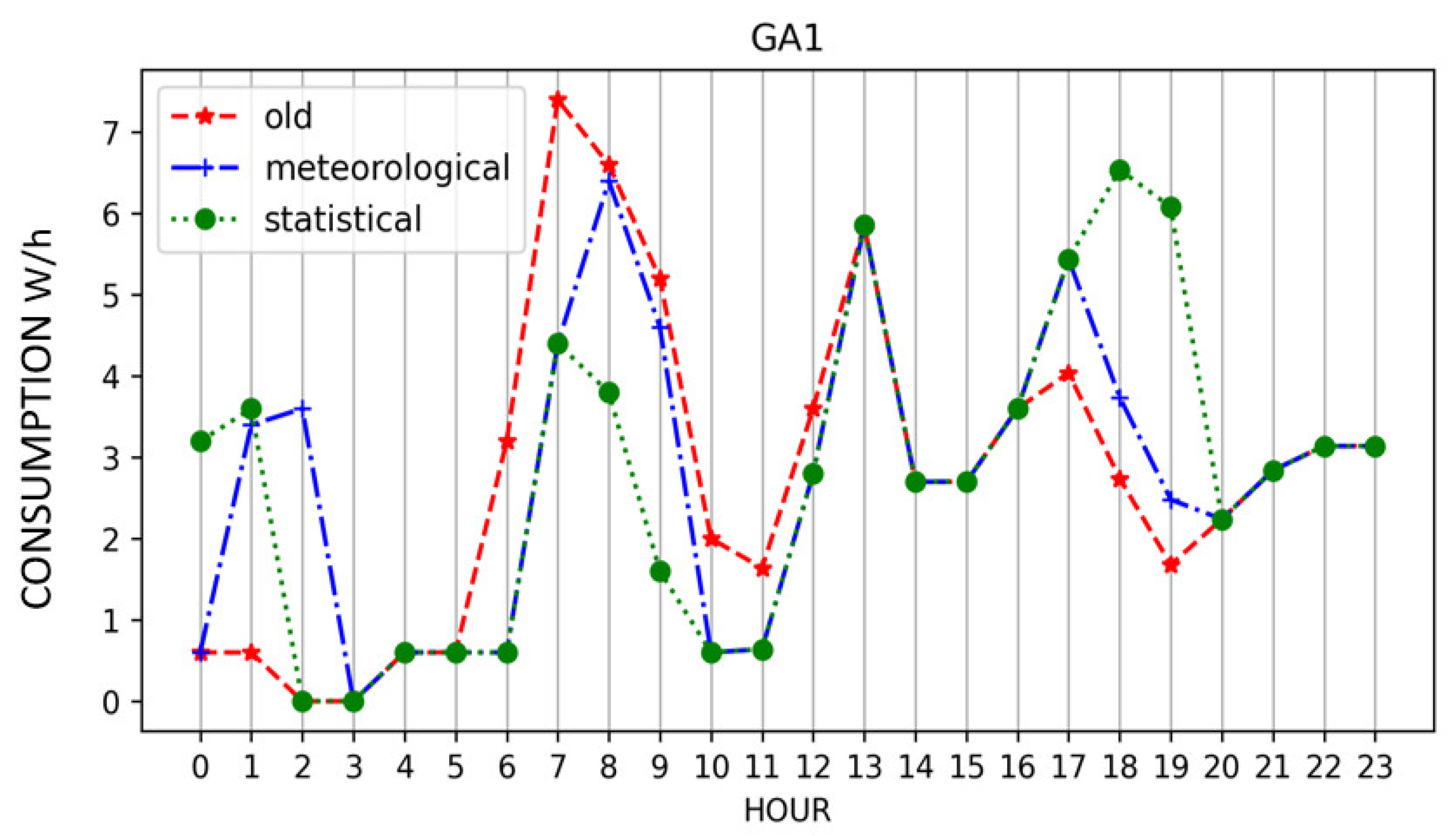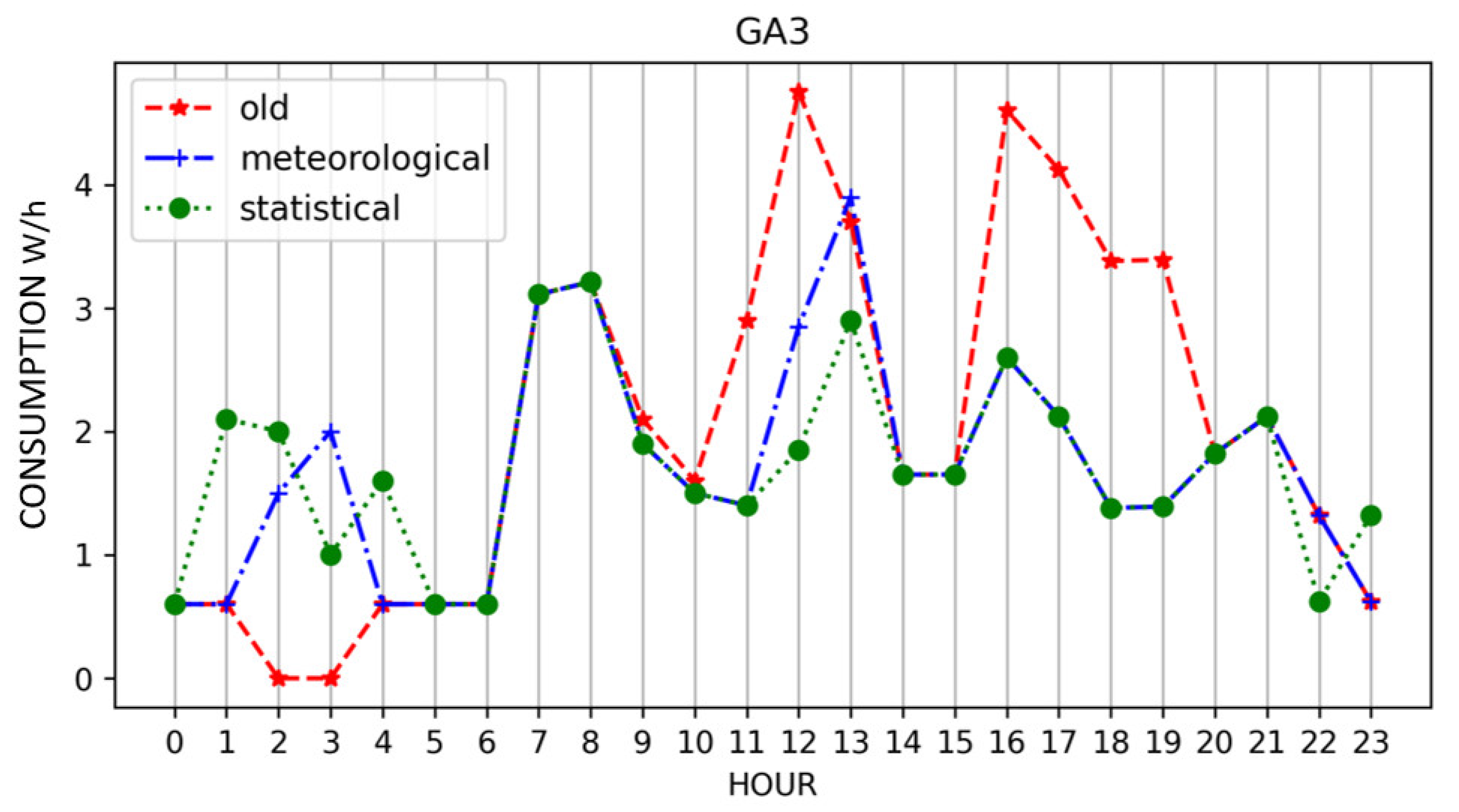MIRROR: Methodological Innovation to Remodel the Electric Loads to Reduce Economic OR Environmental Impact of User
Abstract
:1. Introduction
2. Related Works
3. Methods
3.1. Data Acquisition
3.2. Prediction
3.2.1. Consumption Prediction
- devices for occasional use: all devices used when needed and not for continuous use (e.g., TV, PC, or similar).
- non-interruptible devices: all devices that cannot be interrupted and require continuous use of current, or are independent of the user’s use (e.g., refrigerators, lighting, alarms).
- interruptible devices (shiftable): all devices that can be interrupted and used later, or programmed (e.g., dishwashers, washing machines, or other smart appliances).
- household composed of two young people (aged between 21 and 30);
- household composed of two elderly persons (with ages over 60 years);
- four-person household (with two household members included with ages between 30 and 50 years and the other two household members ages between 0 and 20 years of age).
3.2.2. Power Production Prediction
- a.
- Meteorological method for GHI prediction
- b.
- Statistical method for GHI prediction
- c.
- Prediction of the power production
3.3. Optimization
- is the total consumed energy in a specific hour of the day.
- is the energy consumed by household appliances at a specific hour of the day. It is important to note that energy consumption is aggregated on an hourly basis because the raw data were sampled at a frequency of six seconds.
- is the energy produced by the photovoltaic system at a specific hour of day.
- is the energy present in the ESS at a specific hour of the day. The sign “” in (Equation (9)) indicates that the ESS could be in discharging (+) or charging mode (−). It is important to highlight that the ESS is not charged by the energy that comes from the grid.
- is the total cost of energy for the day.
- is the cost of energy for electricity at a specific hour of the day.
3.4. Scheduling
4. Dataset
5. Experiments and Results
6. Conclusions
Author Contributions
Funding
Institutional Review Board Statement
Informed Consent Statement
Data Availability Statement
Acknowledgments
Conflicts of Interest
References
- Panwar, N.L.; Kaushik, S.C.; Kothari, S. Role of renewable energy sources in environmental protection: A review. Renew. Sustain. Energy Rev. 2011, 15, 1513–1524. [Google Scholar] [CrossRef]
- Rapporto GSE 2021 sulle Fonti rinnovabili in Italia e nelle Regioni—Federazione ANIE. Available online: https://anie.it/rapporto-gse-2021-sulle-fonti-rinnovabili-in-italia-e-nelle-regioni/ (accessed on 10 December 2022).
- Iqbal, M.M.; Sajjad, M.I.A.; Amin, S.; Haroon, S.S.; Liaqat, R.; Khan, M.F.N.; Waseem, M.; Shah, M.A. Optimal Scheduling of Residential Home Appliances by Considering Energy Storage and Stochastically Modelled Photovoltaics in a Grid Exchange Environment Using Hybrid Grey Wolf Genetic Algorithm Optimizer. Appl. Sci. 2019, 9, 5226. [Google Scholar] [CrossRef] [Green Version]
- Erdinc, O.; Paterakis, N.G.; Mendes, T.D.P.; Bakirtzis, A.G.; Catalao, J.P.S. Smart Household Operation Considering Bi-Directional EV and ESS Utilization by Real-Time Pricing-Based DR. IEEE Trans. Smart Grid 2014, 6, 1281–1291. [Google Scholar] [CrossRef]
- Diamantoulakis, P.D.; Ghassemi, A.; Karagiannidis, G.K. Smart hybrid power system for base transceiver stations with real-time energy management. In Proceedings of the 2013 IEEE Global Communications Conference (GLOBECOM), Atlanta, GA, USA, 9–13 December 2013; pp. 2773–2778. [Google Scholar] [CrossRef]
- Lalitha, A.; Mondal, S.; Satya Kumar, V.; Sharma, V. Power-optimal scheduling for a Green Base station with delay constraints. In Proceedings of the 2013 National Conference on Communications (NCC), New Delhi, India, 15–17 February 2013; pp. 1–5. [Google Scholar] [CrossRef]
- Lorincz, J.; Bule, I.; Kapov, M. Performance Analyses of Renewable and Fuel Power Supply Systems for Different Base Station Sites. Energies 2014, 7, 7816–7846. [Google Scholar] [CrossRef] [Green Version]
- Choi, Y.; Kim, H. Optimal scheduling of energy storage system for self-sustainable base station operation considering battery wear-out cost. In Proceedings of the International Conference on Ubiquitous and Future Networks, ICUFN, Vienna, Austria, 5–8 July 2016; pp. 170–172. [Google Scholar] [CrossRef]
- Kuo, P.-H.; Huang, C.-J. A High Precision Artificial Neural Networks Model for Short-Term Energy Load Forecasting. Energies 2018, 11, 213. [Google Scholar] [CrossRef] [Green Version]
- Rodrigues, F.; Cardeira, C.; Calado, J. The Daily and Hourly Energy Consumption and Load Forecasting Using Artificial Neural Network Method: A Case Study Using a Set of 93 Households in Portugal. Energy Procedia 2014, 62, 220–229. [Google Scholar] [CrossRef] [Green Version]
- Xu, X.; Jia, Y.; Xu, Y.; Xu, Z.; Chai, S.; Lai, C.S. A Multi-Agent Reinforcement Learning-Based Data-Driven Method for Home Energy Management. IEEE Trans. Smart Grid 2020, 11, 3201–3211. [Google Scholar] [CrossRef]
- Iqbal, M.M.; Sajjad, I.A.; Khan, M.F.N.; Liaqat, R.; Shah, M.A.; Muqeet, H.A. Energy Management in Smart Homes with PV Generation, Energy Storage and Home to Grid Energy Exchange. In Proceedings of the 2019 International Conference on Electrical Communication and Computer Engineering (ICECCE), Swat, Pakistan, 24–25 July 2019; pp. 1–7. [Google Scholar] [CrossRef]
- Iqbal, M.M.; Manan, A.; Ali, A.; Sohail, A. Towards an Optimal Residential Home Energy Management in Presence of PV Generation, Energy Storage and Home to Grid Energy Exchange Framework. In Proceedings of the 2020 3rd International Conference on Computing, Mathematics and Engineering Technologies: Idea to Innovation for Building the Knowledge Economy, iCoMET 2020, Sukkur, Pakistan, 29–30 January 2020; pp. 1–7. [Google Scholar]
- Khalid, A.; Javaid, N.; Guizani, M.; Alhussein, M.; Aurangzeb, K.; Ilahi, M. Towards Dynamic Coordination Among Home Appliances Using Multi-Objective Energy Optimization for Demand Side Management in Smart Buildings. IEEE Access 2018, 6, 19509–19529. [Google Scholar] [CrossRef]
- Rahim, S.; Javaid, N.; Ahmad, A.; Khan, S.A.; Khan, Z.A.; Alrajeh, N.; Qasim, U. Exploiting heuristic algorithms to efficiently utilize energy management controllers with renewable energy sources. Energy Build. 2016, 129, 452–470. [Google Scholar] [CrossRef]
- Li, S.; Yang, J.; Song, W.Z.; Chen, A. A Real-Time Electricity Scheduling for Residential Home Energy Management. IEEE Internet Things J. 2018, 6, 2602–2611. [Google Scholar] [CrossRef]
- Aslam, S.; Iqbal, Z.; Javaid, N.; Khan, Z.A.; Aurangzeb, K.; Haider, S.I. Towards Efficient Energy Management of Smart Buildings Exploiting Heuristic Optimization with Real Time and Critical Peak Pricing Schemes. Energies 2017, 10, 2065. [Google Scholar] [CrossRef] [Green Version]
- Nguyen, D.V.; Delinchant, B.; Dinh, B.V.; Nguyen, T.X. Irradiance forecast model for PV generation based on cloudiness web service. IOP Conf. Ser. Earth Environ. Sci. 2019, 307, 012008. [Google Scholar] [CrossRef]
- Sajjad, I.A.; Manganelli, M.; Martirano, L.; Napoli, R.; Chicco, G.; Parise, G. Net metering benefits for residential buildings: A case study in Italy. In Proceedings of the 2015 IEEE 15th International Conference on Environment and Electrical Engineering (EEEIC), Rome, Italy, 10–13 June 2015; pp. 1647–1652. [Google Scholar]
- Kelly, J.; Knottenbelt, W. The UK-DALE dataset, domestic appliance-level electricity demand and whole-house demand from five UK homes. Sci. Data 2015, 2, 150007. [Google Scholar] [CrossRef] [PubMed] [Green Version]
- Urraca, R.; Gracia-Amillo, A.M.; Koubli, E.; Huld, T.; Trentmann, J.; Riihelä, A.; Lindfors, A.V.; Palmer, D.; Gottschalg, R.; Antonanzas-Torres, F. Extensive validation of CM SAF surface radiation products over Europe. Remote Sens. Environ. 2017, 199, 171–186. [Google Scholar] [CrossRef] [PubMed] [Green Version]
- Urraca, R.; Huld, T.; Gracia-Amillo, A.; Martinez-De-Pison, F.J.; Kaspar, F.; Sanz-Garcia, A. Evaluation of global horizontal irradiance estimates from ERA5 and COSMO-REA6 reanalyses using ground and satellite-based data. Sol. Energy 2018, 164, 339–354. [Google Scholar] [CrossRef]
- T. T. C. Inc. Available online: https://app.tomorrow.io/home (accessed on 10 December 2022).




| Daily Initial Consumption (€) | Daily Optimized Consumption (Meteorological) (€) | Daily Optimized Consumption (Statistical) (€) | |
|---|---|---|---|
| User 1 | 17.4936 | 8.2495 | 10.0484 |
| User 2 | 8.1198 | 0.4782 | 0.8866 |
| User 3 | 12.9331 | 1.7787 | 3.4489 |
| Daily Savings Consumption % (Meteorological) | Daily Savings Consumption % (Statistical) | |
|---|---|---|
| User 1 | 52.8428 | 42.556 |
| User 2 | 94.1107 | 89.081 |
| User 3 | 86.2469 | 73.3328 |
| Mean Saving Percentage | 77.73347 | 68.3233 |
| Max Daily Peak Not Optimized (W/h) | Max Daily Peak Optimized (W/h) (Meteorological) | Difference [%] | |
|---|---|---|---|
| User 1 | 7.40 | 6.40 | 13.51 |
| User 2 | 3.8 | 3.8 | 0 |
| User 3 | 4.75 | 3.9 | 17.895 |
| User 4 | 7.40 | 6.40 | 13.51 |
| Max Daily Peak Not Optimized (W/h) | Max Daily Peak Optimized (W/h) (Meteorological) | Difference [%] | |
|---|---|---|---|
| User 1 | 7.40 | 6.54 | 11.62 |
| User 2 | 3.8 | 4.8 | −26.316 |
| User 3 | 4.75 | 3.21 | 32.421 |
| User 4 | 7.40 | 6.54 | 11.62 |
Disclaimer/Publisher’s Note: The statements, opinions and data contained in all publications are solely those of the individual author(s) and contributor(s) and not of MDPI and/or the editor(s). MDPI and/or the editor(s) disclaim responsibility for any injury to people or property resulting from any ideas, methods, instructions or products referred to in the content. |
© 2022 by the authors. Licensee MDPI, Basel, Switzerland. This article is an open access article distributed under the terms and conditions of the Creative Commons Attribution (CC BY) license (https://creativecommons.org/licenses/by/4.0/).
Share and Cite
Chimienti, M.; Danzi, I.; Impedovo, D.; Pirlo, G.; Semeraro, G.; Veneto, D. MIRROR: Methodological Innovation to Remodel the Electric Loads to Reduce Economic OR Environmental Impact of User. Algorithms 2023, 16, 1. https://doi.org/10.3390/a16010001
Chimienti M, Danzi I, Impedovo D, Pirlo G, Semeraro G, Veneto D. MIRROR: Methodological Innovation to Remodel the Electric Loads to Reduce Economic OR Environmental Impact of User. Algorithms. 2023; 16(1):1. https://doi.org/10.3390/a16010001
Chicago/Turabian StyleChimienti, Michela, Ivan Danzi, Donato Impedovo, Giuseppe Pirlo, Gianfranco Semeraro, and Davide Veneto. 2023. "MIRROR: Methodological Innovation to Remodel the Electric Loads to Reduce Economic OR Environmental Impact of User" Algorithms 16, no. 1: 1. https://doi.org/10.3390/a16010001
APA StyleChimienti, M., Danzi, I., Impedovo, D., Pirlo, G., Semeraro, G., & Veneto, D. (2023). MIRROR: Methodological Innovation to Remodel the Electric Loads to Reduce Economic OR Environmental Impact of User. Algorithms, 16(1), 1. https://doi.org/10.3390/a16010001







